Contents
Dried plum, or prunes, is a popular, affordable and beloved delicacy by many. It not only tastes good, but is also famous for its many health benefits. It is easy to purchase in a store or on the market in finished form, however, in the production of dried plums in industrial conditions, chemicals that are unsafe for human health are often used. An excellent alternative to a purchased product is prunes cooked at home, especially since this is not at all difficult to do. The main thing is to choose the right fruits that are suitable for drying or drying, as well as decide on the recipe, since there are many options for them.
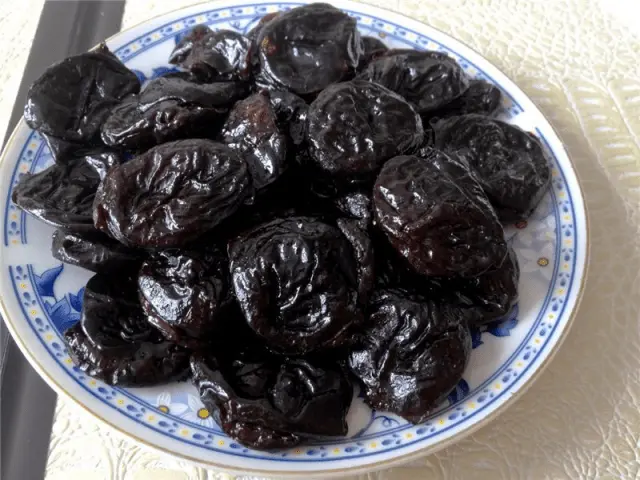
Benefits of dried plum
The range of useful qualities that this product has is very wide:
- dried plum in an easily digestible form contains many trace elements (potassium, calcium, iron, sodium, iodine, phosphorus, chromium, fluorine), vitamins (C, A, E, P, PP), substances necessary for the human body (fiber, pectin , fructose, organic acids, proteins);
- it improves the functions of the gastrointestinal tract, improves digestion and stimulates appetite;
- dried plum has a mild laxative effect, helps to normalize metabolism;
- it has a beneficial effect on the work of blood vessels, clearing them of cholesterol plaques, reduces pressure in hypertension;
- antioxidants in dried plums improve blood circulation, helping with anemia;
- it removes excess fluid and salts from the body, relieving edema;
- dried plum fights pathogenic bacteria in the body, reducing the number of E. coli, staphylococcus, salmonella;
- with regular use, strengthens bone tissue, preventing osteoporosis;
- dried plum is indispensable for beriberi, decreased performance and loss of strength;
- it is considered an excellent natural antidepressant.
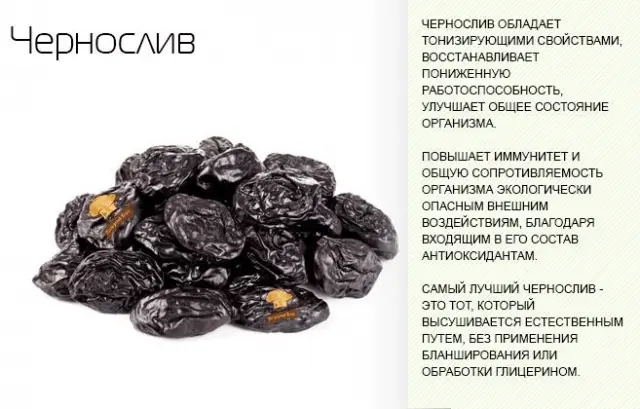
There are very few contraindications for the use of prunes, but they exist. It is undesirable to uncontrollably get involved in dried plums:
- people suffering from obesity;
- having problems with kidney stones;
- patients with diabetes mellitus;
- breastfeeding mothers.
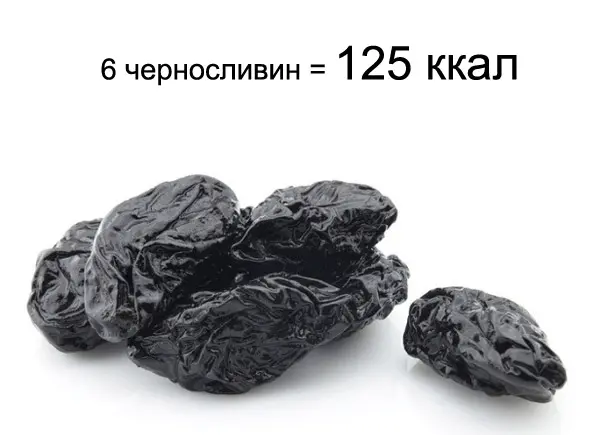
How to dry plums at home
In order for homemade prunes to turn out “perfectly”, it is important to know which varieties of plums are best dried, and how to properly pre-prepare it.
What kind of plum can be dried
It is generally accepted that dried plums are best obtained from Hungarian (Donetsk, Kuban, Belorusskaya, Italian, Moscow, etc. varieties) due to the optimal content of sugars and pectin in fruits. However, other plums can also be perfectly dried:
- Kyustendil blue;
- renklody;
- would take
Fruits, from which excellent prunes will surely turn out, are chosen according to the following criteria:
- well ripened – ideally, weighing about 30–40 g, with a medium-sized bone;
- hard, dense to the touch, beautiful, without rot and damage;
- high content of solids in the pulp (17% or more);
- sweet (at least 12% sugar), with a slightly pronounced “sourness”.
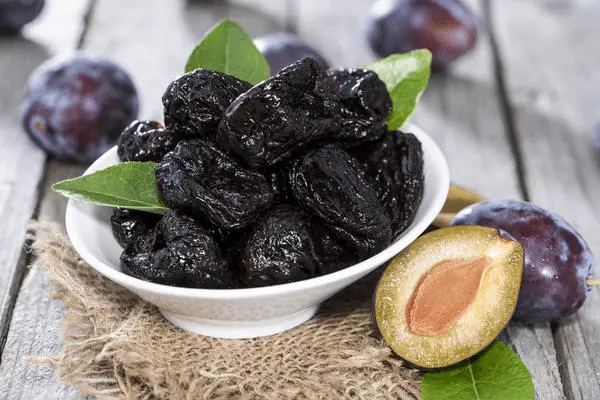
Preparing plums for drying
Plums that are supposed to be dried must be fresh – after harvesting from the tree, they should not be stored for more than 1 day.
First you need to prepare them:
- sort by size to dry the same fruits together;
- remove the stalks and leaves;
- Rinse well under running water and pat dry with paper towels.
- cut in half and remove the seeds (if you plan to harvest prunes without them – small fruits, as a rule, are best dried whole).

How to dry a plum correctly
High-quality dried plums at home can be obtained in various ways – you just have to choose the most preferred and convenient one for yourself.
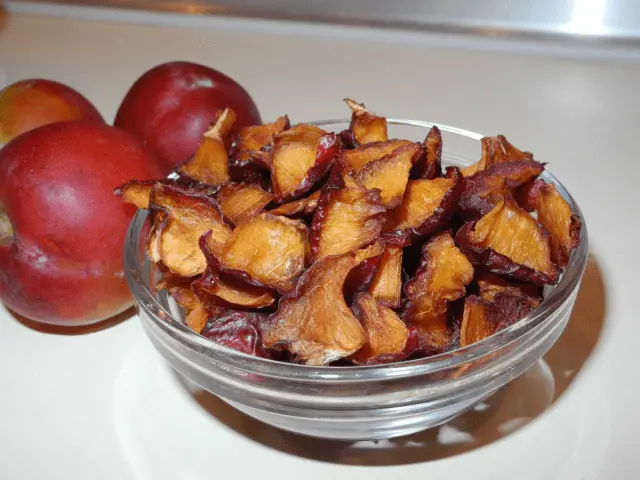
Drying drains in an electric dryer
This option resembles the industrial drying of fruits by the “fire” method – by heat treatment in special chambers – but adapted for home cooking. The “plus” of this technology is that it turns out to dry the plum very quickly – within a few hours.
Before drying, the prepared fruits are blanched – dipped for about half a minute in boiling water with the addition of baking soda (about 1 g per 15 liter). Then they are washed in cold water and allowed to dry.
After that, the fruits are laid out in one row on pallets of an electric dryer. Next, the dried plum is prepared in three stages. After each of them, pallets with fruits are taken out of the unit and cooled to room temperature:
How long to dry (hours) | At what temperature (degrees) |
3,5 | 50 |
3 – 6 Feet | 60 – 65 Feet |
3 – 6 Feet | 70 |

How to dry plums in the oven
For self-preparation of dried plums, it is quite possible to use the oven of a home stove. In this case, the fruits will have to dry for about 2 days.
To begin with, as in the previous recipe, the fruit must be blanched in boiling water with soda, rinsed and dried.
Baking trays of the oven must be covered with culinary parchment and the fruits are laid out on it (if they are halves, then they should be placed cut up).

Next, you need to send the plums to a preheated oven. Drying them also has to be done in several stages:
How long to dry (hours) | At what temperature (degrees) |
8 | 50 – 55 Feet |
8 | 60 – 65 Feet |
24 | Remove from oven and keep at room temperature |
8 | 75 – 80 Feet |
How to dry plums in the sun
The method of preparing dried plums in the sun and fresh air is certainly accessible and simple. However, it takes a long time (from 7 to 10 days) and requires good weather.
Pre-prepared fruits are laid out in wooden boxes or on grates and taken out to dry in the open air under the sun’s rays, where they are left for the whole day. In the evening, the containers are hidden in the room and again exposed to the sun the next morning – after the dew has disappeared. As a rule, these actions are required to be repeated from 4 to 6 days. Then the fruits should be dried for another 3-4 days in the shade.
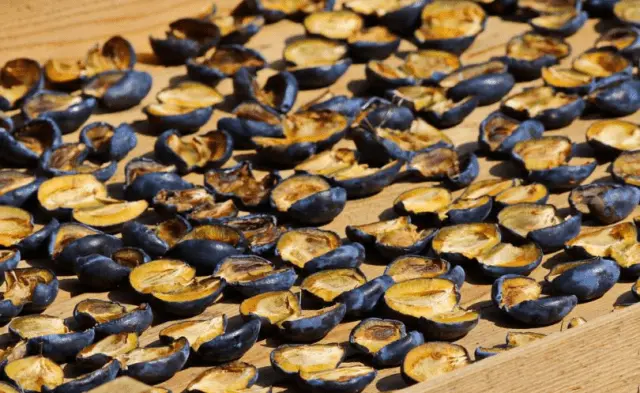
How to Dry Plums in the Microwave
The microwave oven allows you to dry plums in an “express way” – in just a few minutes. But at the same time, it is necessary to control the process very carefully, otherwise coals may appear instead of prunes at the output. In addition, drying fruits in large portions will not work.
Pitted plum halves should be placed cut side up on a flat plate that is suitable for use in the microwave. Put paper towels on the bottom of the container and on top of the fruit slices.
First, a plate with fruits must be placed in the microwave for 2 minutes. Next, the timer must be set to the very minimum (10–20 seconds) and constantly check the product until it is ready, preventing it from burning out.
Dried plum, cooked properly, feels soft and elastic to the touch, and when pressed, juice will not stand out from it.
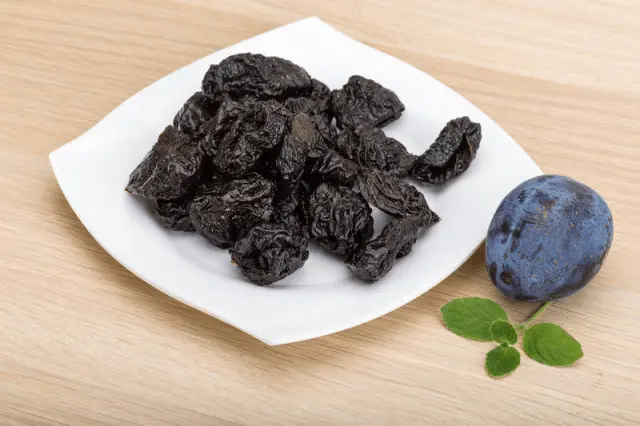
How to dry a plum at home in an air grill
You can also cook dried plums in an air grill. It turns out dense, beautiful in appearance, with a slight aroma of smoked meat. The disadvantage of this method is the relatively small yield of the finished product (from 1 kg of fruit, only about 200 g of dried plums are obtained).
Prepared fruits are placed in the air grill at several levels. They should be dried at a temperature of 65 degrees. The device is turned on for 40 minutes, then the fruit is left to cool for an hour. Such actions are performed 2-3 times, after which the dried plum is laid out on paper and allowed to “rest”. The next day, the procedure is repeated.
How to dry yellow plum
Plums of yellow varieties are often called “honey” for the sweet taste of tender, juicy pulp. It can also be dried using the rules and technologies described above.

Many varieties of cherry plum are also distinguished by a yellow integumentary skin. This fruit is recommended to be dried in the same ways that are suitable for ordinary plums. The finished product has a sour taste, brown or brownish color. Compared to ordinary dried plum, it is somewhat tougher.

How to store dried plums
Dried plums are recommended to be stored in a dark, dry and cool place. Fabric bags, wooden or cardboard boxes, paper bags are perfect as containers.
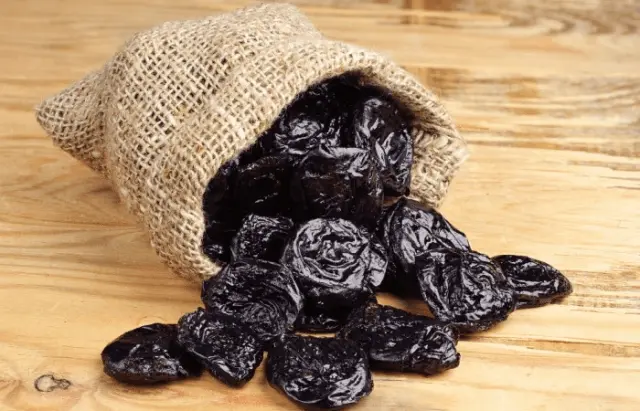
It is also allowed to store dried plums in glass jars, but in this case it is better to keep them in the refrigerator.
The shelf life of homemade prunes, prepared according to all the rules, is 1 year.
Plum, dried plum at home
Drying is another interesting and inexpensive option for harvesting plums for the future for the period of autumn and winter. Dried plum differs from traditional dried plums in that it is not aged for so long and at lower temperatures, as well as in a certain additional preparation of fruits before cooking. There are even more recipes for dried plums than there are ways to dry them.
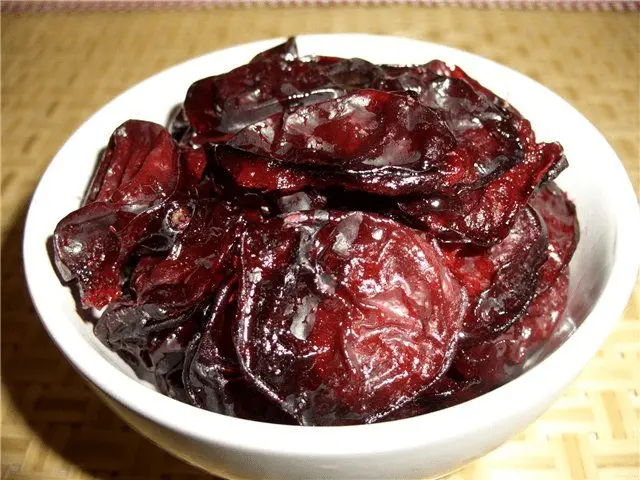
Dried plums in the oven
The easiest way is to wither the fruits in the oven without any frills. The result can be a wonderful addition to meat and fish dishes, a savory salad ingredient, or a great addition to savory pastries.
You should take:
- 0,5 kg of well-ripened plums (any variety is suitable);
- some olive oil;
- a little salt;
- dry fragrant herbs.
Preparation:
- Cut the fruit in half, remove the seeds.
- Line a baking sheet with parchment paper. Lay out the fruit halves in dense rows (cut up), salt and drizzle with olive oil.
- Preheat oven to 80-90 degrees. Place the baking tray with fruit slices on the upper level and dry for about 45-50 minutes with the door slightly open.
- Close the oven, turn off the heat and wait a few hours for the slices to cool completely.
- Sprinkle them with a mixture of aromatic herbs and repeat steps 3 and 4 again.
- Transfer the finished product to a glass jar, pour olive oil and refrigerate for storage.
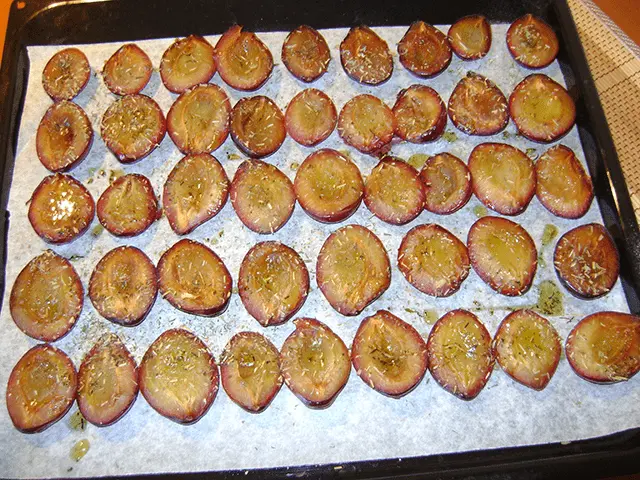
Plum fried with garlic
A few cloves of garlic will add a piquant flavor to the dried plum.
You should take:
- about 1,2 kg plums;
- 5 tbsp. olive and vegetable oil;
- 5-7 cloves of garlic;
- 2 pinches of coarse salt (table or sea);
- 2,5 tsp dry aromatic herbs.
Preparation:
- Lay the halves of the washed and pitted fruit cut side up on a baking sheet lined with baking paper. Sprinkle with salt and herb mixture.
- Put the baking sheet in the oven, heated to 100 degrees. Dry with the door ajar for 2 to 3 hours, carefully controlling the process so that the fruit does not burn.
- At the bottom of a sterilized, dry glass jar, put a little chopped garlic into thin slices, then halves of dried plums, then sprinkle with herbs. Repeat layers until container is full.
- Add a mixture of sunflower and olive oils to the jar so that the fruits are completely covered. Close the lid and put in the refrigerator.
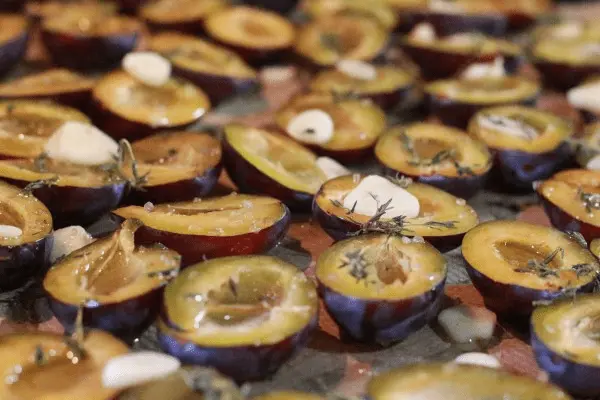
Dried plums in an electric dryer
Dried plum cooked in an electric dryer is very tasty. This appliance can maintain a constant temperature for a long time, which allows you to dry fruit slices completely and evenly without leaving them too juicy in the middle.
You should take:
- 1,5 kg plums;
- 0,1 l of vegetable oil (preferably olive);
- about 15 g of salt;
- 2 heads of garlic;
- 1 pod of hot red pepper;
- 1 tbsp. mixture of dry herbs (basil, parsley).
Preparation:
- Cut the washed fruit in half, remove the pits and arrange cut side up on a wide plate or cutting board.
- Put a thin plate of garlic and a small amount of finely chopped hot pepper on each of the slices, add salt and sprinkle with herbs.
- Carefully transfer the slices to the dryer tray. Tumble dry for about 20 hours on medium heat.
- Put the finished product in a glass container, pour vegetable oil and store in the cold.

Sweet dried plums in the oven
Dried plums can be not only sour, spicy or spicy. An excellent result will also be obtained if you cook them with the addition of granulated sugar.
You should take:
- 1 kg of plum fruits;
- 100 d Sahara.
Preparation:
- Wash the fruits, cut in half and remove the seeds.
- Place the slices in a saucepan, cover with sugar and place oppression on top. Remove to a cold place for several hours until the juice is given.
- The resulting juice should be drained, and the fruit slices should be laid out on a baking sheet (after spreading a sheet of cooking parchment on it).
- Send to the oven, preheated to 65 degrees. Dry until the surface of the fruit “grabs” from above (while the pulp inside should remain elastic).
The method of preparing sweet dried plums in the oven, similar to the one presented above, is very clearly shown in the video:
Plums Dried in Syrup
You can also wither plums in the oven, after soaking them in sweet syrup – you get another original delicacy that children will undoubtedly appreciate. However, the taste of healthy “sweets” from a natural product will certainly not leave indifferent adult lovers of sweets.
You should take:
- 1 kg of ripe and sweet plums;
- 700 d Sahara.
Preparation:
- Seedless fruits, cut into halves, sprinkle with sugar (400 g) and leave for about a day.
- Drain the resulting juice.
- Make syrup with 1 cup (250 ml) water and remaining sugar. Pour the halves of the fruit over them and let stand for about 10 minutes.
- Drain the slices in a colander, then arrange on a baking sheet lined with baking paper.
- Put the plums in the oven heated to 100 degrees. Dry for 1 hour, then let cool. Repeat until the desired degree of dryness is reached.
Dried plums: a recipe for Italian chefs
The recipe for spicy dried plums in oil was once born in Italy. A special “note” to the characteristic sweet and sour taste of this snack is given by the combination of honey with aromatic herbs.
You should take:
- about 1,2 kg of solid plums;
- 1 tbsp honey (liquid);
- 80 ml of olive oil;
- 50 ml of vegetable (sunflower) oil;
- 4-5 cloves of garlic;
- a pinch of sea salt;
- mixture of dried mediterranean herbs.
Preparation:
- Peeled fruit, cut into quarters and spread with the pulp up on a baking sheet covered with baking paper or foil, lightly oiled.
- In a small bowl, mix vegetable oil with honey.
- Pour the fruit slices with the mixture, sprinkle with herbs, lightly salt.
- Send the baking sheet to the oven (heating it to 110-120 degrees). Dry for 2-3 hours until the desired degree of softness of the fruit.
- Fill the glass container, alternating layers: ready-made fruits, finely chopped garlic, herbs. Pour in hot olive oil.
- After cooling, remove the snack on the shelf of the refrigerator.
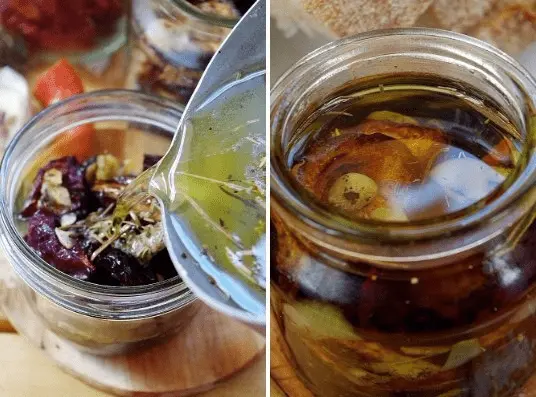
How to dry a plum in a slow cooker
To prepare dried plums in a slow cooker, you will need a grate that allows you to steam.
You should take:
- 1 kg plums;
- 1 tbsp olive oil;
- 1 tsp sea salt and dried herbs.
Preparation:
- The fruits must be washed and cut into “slices”, removing the seeds.
- Put a circle of parchment on the bottom of the multicooker bowl, lay out half of the prepared slices. Sprinkle with salt and herbs, drizzle with oil.
- Install the grill in the appliance. Place the remaining slices on it. Salt, sprinkle with herbs, sprinkle with the remaining oil.
- Open multicooker valve. Close the lid of the appliance tightly and set the “Baking” mode for 1 hour.
- At the end of the time, try the product. If you need to dry the plums to the desired degree of readiness a little more, extend the cooking time by a quarter of an hour.
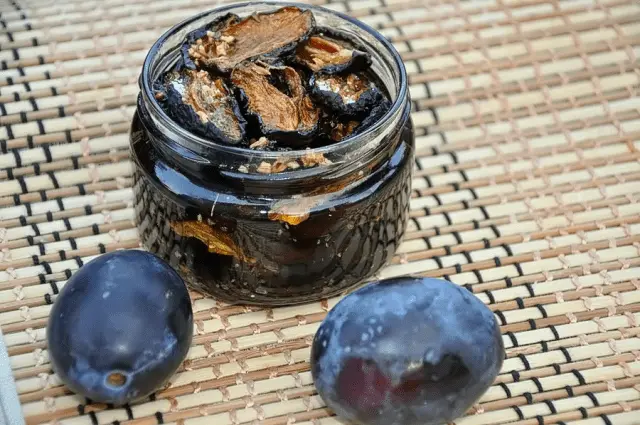
How to dry plum with cinnamon and cloves at home
An unusual version of a very sweet and fragrant dried plum billet will turn out if you add cloves and cinnamon powder as spices, and use liquid honey as a filling.
You should take:
- 1 kg plums;
- 0,3 l of honey (liquid);
- 1 tsp (without top) ground cinnamon and cloves.
Preparation:
- Seedless fruits, cut into slices, put in a deep container, sprinkle with a mixture of cloves and cinnamon. To stir thoroughly.
- Lay the slices on a baking sheet lined with parchment. Dry in the oven at 110 degrees for about 2,5 hours.
- Place the finished product in a jar, pour liquid honey to the top and roll up the lid.
Terms and conditions of storage of dried plums
In order for the dried plum, harvested for future use, not to deteriorate, you need to know how to store it properly:
- spicy plums filled with olive oil or honey (an excellent preservative) can be stored in a tightly closed container on the refrigerator shelf for 1 year;
- sweet dried fruits (without pouring) are advised to be kept in airtight containers, after sprinkling the slices with sugar or powder.
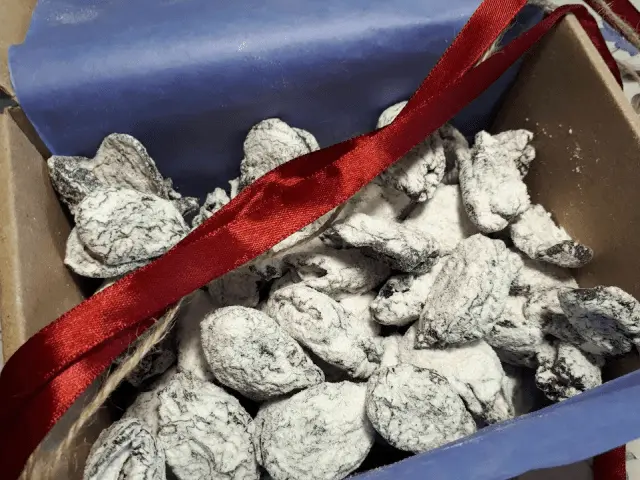
Conclusion
Dried plums are an excellent homemade option for this product for the future. Its preparation does not require large investments of money or labor – even a novice hostess can handle it without problems. There are many recommendations on how to dry or dry a plum. It can be sour, sweet or spicy, and can be used as a stand-alone dish or used as an additional ingredient in recipes. It is enough to try to cook a plum once according to one of the proposed methods – and you will definitely want to continue experimenting with it in the kitchen.









